| The
Celebrity Collector
Billy Dee Williams,
suave and sexy movie star,
collects cookie
jars!
By Ken Hall
Almost
as eyebrow-raising as the fact that Billy Dee Williams collects
cookie jars is the story of how he got into it. "Originally I
planned on starting a teapot collection," the film star and sex
symbol recalled. "I really like them. But I found out that my friend
Peter Max (the pop artist) was already collecting teapots, so I
thought, 'I can't be copying his collection -- I've got to find
something else!'"
That something else turned
up in a little store called The Opera Shop in West Hollywood,
Calif., about ten years ago. "It's a little store with all kinds of
opera-related stuff," Billy Dee said. "I'm a fan of the opera and I
was in there looking around, and I saw this beautiful and colorful
ceramic cookie jar, made to resemble an opera singer. I bought it on
the spot. I think I paid about $125 for it."
On a return trip to the
shop, Williams noticed there were more of the jars for sale, equally
as colorful and alluring as the opera singer. "They had one of a
Fats Waller-type singer at a piano, and one of Josephine Baker, the
black performer from the '30s," he remembered. "I bought both of
them. They were obviously done by the same person, so I did a little
detective work to find out who it was."
His search led him to an
artisan couple in Santa Fe, N.M., named Michael and Shelley
Buonaiuto, transplants from New York who had been making the jars,
as well as other ceramic and porcelain items, for years. They had
about 18 cookie jars in their line, which they mass produced for
individual customers and specialty shops across the country. Billy
Dee became a regular buyer.
"I would say I've got 12 or
13 of their jars," Williams said. "They're all packed away right
now. I had them in a studio, but I've been moving things around, so
right now they're in storage. I plan on expanding the collection,
probably to include more of Michael and Shelly's stuff but maybe
other kinds as well. They've set the bar pretty high, though.
They're beautiful, original, colorful pieces."
And, ironically enough,
discontinued (except for one piece, a Mrs. Rosa Parks jar). "We
stopped making them because they were just too labor intensive,"
said Michael Buonaiuto. "We may resurrect them someday, but for now
we're making sculptures in clay, cast bronzes and cast resin
pieces." Michael's and Shelley's creations can be seen on their web
site at http://www.alittlecompany.net/.
The Buonaiutos got a quick
lesson in the fiercely aggressive world of collectibles when they
first began producing the cookie jars in the early 1980s. "We
started out making them as functional items," Michael said. "We
really believed people would put cookies in them. We found out
pretty fast that nobody was using them for cookies. It's incredible
how many people are collecting cookie jars."
No kidding. According to http://www.tias.com/,
a web site that monitors trends in the antiques and collectibles
industry, cookie jars were the #2 collectible in 2001, second only
to china. After cookie jars, the list continues as follows: dolls,
furniture, lamps, carnival glass, books, plates, Depression glass,
Roseville, china dinnerware, McCoy, Avon, clocks, Noritake, teapots,
figurines and Limoges.
Michael and Shelley rode
the cookie jar wave for years, she as the artist and designer, he
the one who cast the moulds. Shelley said she was drawn to black
subjects for her art while living in Boston, where she hung out with
jazz musicians. "There's a freedom to the jazz scene that attracts
me," she said. "I try to put a quality of soul into the pieces I do.
That's the thing people respond to."
To produce a cookie jar,
from start to finish, Shelley would first come up with a design idea
and sculpt a creation based on her vision. Michael would then
"dissect" the sculpture and fashion a mould. Then the piece would be
cast and colors decided on. The couple conferred with 5-10 different
painters before they got the look they were searching for. There was
little wiggle room after that.
""The market pushed us to
get more elaborate and detailed," Michael said. "We painted the
microphone gold for the jazz singer, for example. But what we
discovered was that nobody wanted individual creations. Once a jar
was put into mass production, that was it. If we got creative with
the colors, we'd get negative feedback. The collectors wanted what
came off the assembly line, period."
So, Billy Dee Williams, or
any other fan of the Buonaiuto cookie jar line, is going to have to
log onto eBay or somehow seek out other collectors to find the
pieces they want. Billy Dee's comment about wanting more jars may,
by necessity, force him to consider the talents of other artists. He
won't be alone. As the #2 collectible, cookie jars will doubtless
spawn new and talented creators.
Billy Dee Williams was born
in 1937 and grew up in the Harlem section of New York City. His
family actively encouraged his artistic abilities and his talents
emerged early on. While still a boy, he earned a scholarship to the
National Academy of Fine Arts and Design in New York. Ironically, it
was the need to earn money to buy paints and canvas that led to his
extensive credits in film and TV.
Over the objections of his
art instructors, young Billy Dee developed his talents in acting. He
made his Broadway debut in The Firebrand of Florence -- at age 7! In
the years that followed, his life was dominated by the performing
arts. He achieved star status for his movie roles and is remembered
for his suave, romantic performances in movies such as Lady Sings
the Blues and Mahogany.
He acted in one of the
top-grossing motion pictures of all time, playing the character
Lando Calrission in Star Wars: The Empire Strikes Back. He reprised
the role in Return of the Jedi. On TV, Williams played a greedy
record baron on the long-running series Dynasty. And he was
nominated for an Emmy when he portrayed football star Gayle Sayers
in the critically heralded Brian's Song.
In 1988, when Billy Dee
returned to the New York stage to star in Fences, it marked a
turning point in his life. He was given the chance to go back to his
home and the center of the art scene. The experience reawakened the
painter in him. When it was time to go back to California (where he
was living then, and still does today), it was with a wealth of new
ideas for his artistic expression.
In two years' time,
Williams cranked out 120 original works of art. Since 1991, he has
had numerous solo art exhibitions across the country. He's also
donated his work to the National Portrait Gallery in Washington,
D.C., and the Schomburg Museum in New York. His many influences
include Edward Hopper, Thomas Hart Benton, MC Escher, Frida Kahlo
and numerous African art forms.
Among his other interests,
Williams has had a long fascination with psychic phenomena and
psychic readings. He teamed with award-winning author Rob MacGregor
to write PSI/Net, a novel based on an actual government program of
psychic spying. His recent acting credits include the films
Undercover Brother (Universal, produced by Ron Howard) and
Constellation, with Chris Kattan.
Fans of Billy Dee Williams
may visit the star online at his website: http://www.bdwworldart.com/.
2002
|
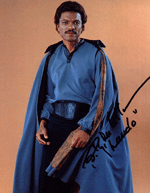
Billy Dee played
Lando Calrissian in the Star Wars epics The Empire Strikes Back and
Return of the Jedi.
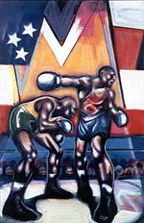
"The Boxer" is one
of many Billy Dee paintings that carries a sports theme. His work is
sold online.
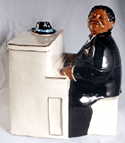
Billy Dee discovered
the cookie jars made by Michael and Shelley Buonaiuto while browsing
at The Opera Shop in West Hollywood. He's got about a dozen of their
jars, which have been discontinued. Above is
"Fats."
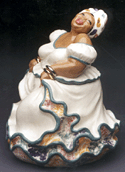
Bella
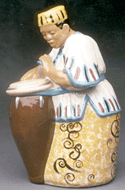
Amos
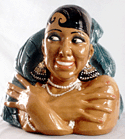
Josephine
Baker |